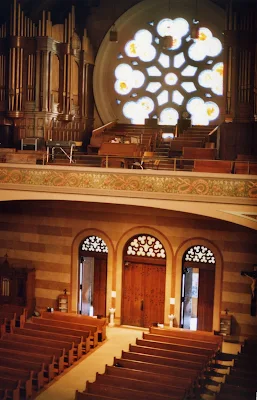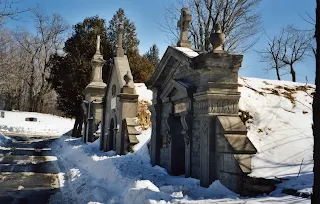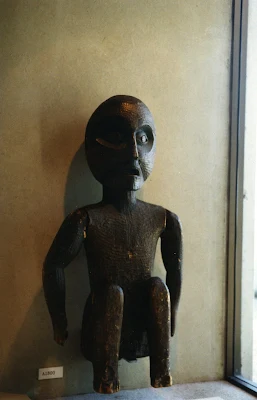 In winter, from St. Philip's Anglican Church across the street. .
In winter, from St. Philip's Anglican Church across the street. .Saturday, February 28, 2009
Sunday, February 22, 2009
Saturday, February 21, 2009
Friday, February 20, 2009
Where The Molsons Are Buried


 The doors to the Molson mausoleum, decorated with bare breasted angels, have now been removed as they had severely deteriorated over the years. These angels are, truly, an affirmation of life in the midst of death, even though someone doesn't know that angels are male and not female; anyhow, p,laying along with the eroticism these particular female angels are more abundantly endowed than one would expect. Perhaps there is an interesting story behind their creation.
The doors to the Molson mausoleum, decorated with bare breasted angels, have now been removed as they had severely deteriorated over the years. These angels are, truly, an affirmation of life in the midst of death, even though someone doesn't know that angels are male and not female; anyhow, p,laying along with the eroticism these particular female angels are more abundantly endowed than one would expect. Perhaps there is an interesting story behind their creation.
Wednesday, February 18, 2009
Tuesday, February 17, 2009
Monday, February 16, 2009
Sunday, February 15, 2009
Saturday, February 14, 2009
Artie Gold, two years later

"Language, without the monkey of historical reality clinging to its back, is poetry!!"
--Artie Gold
(Artie's handwriting and design on a piece of plastic)
____________________________________________
It was on this day two years ago, February 14, 2007, that Artie Gold died. I often go for walks and pass the apartment building on Sherbrooke Street West where he lived. At night, from the street, I can look up at his windows and see that new people have painted and decorated his old place. Not long ago I entered the building, the inside door unlocked when one of the tenants was entering. I went up to the second floor where Artie’s apartment was located; there was no aura of Artie left, it had long departed; the books of poetry Artie wrote and our memories of him are all that we have left.
What memories do we have? Artie was someone who talked, rather than listened. He was an intelligent man, one of those people who seem to have been born knowing something about many things. He had charisma and a terrific sense of humour. He could be kind but he also managed to alienate many of his friends. A few old friends looked after him in his final years as he was not well and left his home only infrequently; I think of Endre Farkas, Luci King-Edwards, and Jill Torres in particular as friends who did much for Artie. I apologize for omitting the names of any others who helped him. I also visited, bought groceries, T-shirts, sole inserts, and other things he needed; and CZ and I had coffee with him at different restaurants. He often phoned. He saw few people and he allowed even fewer to enter his apartment. Artie was not someone to whom one could be indifferent. Some of us who knew him for many years thought he was fated to die young, but he managed to live sixty years and exactly one month.
Once Artie showed me a book by the American poet Larry Eigner with the author’s name, where it had been written in pencil inside the book, erased but still visible. The printing was a scrawl as a result of Eigner’s cerebral palsy. Looking at Eigner’s photograph at the back of his The World And Its Streets, Places (Santa Barbara, Black Sparrow, 1977), I noticed the similarity of how Artie looked with Eigner’s appearance. Both men, at age fifty—Eigner in 1977 and Artie in 1997—are balding but still attractive men, both were dedicated to poetry despite their physical health.
Artie Gold was one of our most talented poets. His bad health was partly self-inflicted, and partly the result of childhood health problems. He came from a fairly well off family in Outremont, a neighbourhood in Montreal which is mixed socially but is also very upper middle-class. His father was a businessman who made trips to China as far back as the early 1970s. Artie suffered greatly in his life, due both to his emotional and physical condition. We will not see his like again, for no one would want to live his life and few would put up with what he endured, not even Artie Gold by the end.
Thursday, February 12, 2009
Tuesday, February 10, 2009
Monday, February 9, 2009
Notes on The Mystic Beast (1997)
 |
| The Mystic Beast, 1997 |
I first discovered the sculpture that I call “The Mystic Beast” (The Mystic Beast, Empyreal Press, Montreal 1997) around 1994 at Vancouver’s Museum of Anthropology, a museum that is largely dedicated to the art of First Nations people in British Columbia. He (the sculpture) was in a room just after the main hall as one enters the museum, placed off to one side near a window, so he is easily missed. In fact, the sculpture is a Northwest coast Nimpkish wood sculpture of a human figure, made around 1893. When I first saw him, I felt as though I had met my doppleganger; however, instead of a human double, it was an inanimate object.
I think CZ and I both immediately recognized the facial similarity that I shared with the Mystic Beast, but it was more than the expression on the face, it was also spiritual. I knew the meaning of his expression—so indicative of how I felt in life—for it showed my inner being: it was the face of an introvert trapped in a room full of extroverts; it was the face of one who is more at home being alone than with other people. It is a curious and rare experience to find a visual expression of one’s inner being, of one’s identity as a human being; he did not represent my persona, but the private face of the condition of my soul, he was the face of my Shadow.
The “Shadow” contains the aspects of our psychology that we reject, deny having, are afraid to face, and so on. They may be parts of our psychology too hurtful for us to deal with, that we would prefer to forget, or it might consist of taboo behaviour, or other aspects of ourselves that we consider too dark and disturbing to acknowledge. What we forget is that the Shadow is full of energy, think of the energy we’ve all used to deny or hide our Shadow; we sometimes project what we don’t like about ourselves onto other people and demonize them; we may go to great lengths and spend many years avoiding the Shadow; we may adopt a new persona (for instance, one that is light and lively) to hide behind, rather than investigate our own inner darkness. I am reminded of the phrase, “the bigger the sun, the bigger the darkness” and how this so often gives an accurate insight into some of the people we meet. However, there is gold in the Underworld; there is light in the darkness; there is redemption from our past; there is a voice of witness reminding us what we need to remember; there is poetry in life’s journey. So, it was epiphanous to find a sculpture, in a museum in Vancouver, representing my inner being, and I associated my Shadow with the sculpture.
At the time when I visited the Museum of Anthropology, I was working on a manuscript of poems entitled The Mystic Beast, the final book in my Shadow Trilogy, and I thought of the sculpture as my twin Mystic Beast. I thought of him as having a similar psychology as myself and there he was, staring at me, or staring off into space. He is physically larger than life size, in fact much larger than he appears in most photographs, and the artist who made him caught perfectly an expression of psychological depth that, I feel, is rare in art found anywhere. When The Mystic Beast was published in 1997, the cover art was by Ed Varney who made an incredible drawing of the face of this sculpture, as can be seen above. A French translation by Élizabeth Robert, entitled La bete mystique (Editions Triptyque, Montreal, 2004) has an equally remarkable cover image, but it is not of the Mystic Beast in Vancouver. (You can see a photograph of The Mystic Beast on the home page of my poetry website, as well as elsewhere in this blog.)
Here is darkness,
here the place
where waves are black
and the wind howling
through trees is a cry:
one thinks of Edward Munch,
the soul become a sheet
in the wind; have I left
a pile of skulls,
a dying heart
where it lies in my chest
as in a desert, tormented
by the sun and wind?
Here is title poem of the collection:
The Mystic Beast
1. The Invention of the Mirror
How could this be me
what I see as myself,
meeting what is
not me
but someone else:
a doppleganger passing
in the street, a twin
I was separated from
at birth, a part
of me divided
and gone,
as though
I lost my shadow
and must stay indoors
to avoid the sun.
The mirrored image
of my right hand
as I raise it
seems to be
my right hand,
but in the mirror
if my right hand is holding a book
the words are reversed—
who we are,
we never see
what we’ve become—
unless a mirror
in which nothing
could be invented
is reversed, words
read as words,
then we could see
for the first time
in human history
our true selves;
meeting ourselves
as others see us
not reversed or backwards.
2. The Mystic Beast
Arriving on the west coast,
I find the perfect image
of myself, a wooden
statue staring
at nothingness
in a museum:
he is the mystic
beast—not reversed
in a mirror,
not divided by life—
but the single
essence of who
I am. This image
is not reversed
by fortune or glass,
silver or animation,
but the inner being
so long separated:
my own face
and body frozen
in time and regret.
It is the unreconstructed
self found at last,
like finding a cousin
or brother, the true
brother of light
and camaraderie
who holds
my arm and announces
the birth of poetry,
the beginning of light,
the conclusion of silence.
It is my self
I find, my lost twin,
the inner being
I was and am,
who escaped
long ago and
disappeared,
a face encountered
in a mirror without
distortion by depression
or a concave in which
I slip into silence;
not the face seen
reflected in store
windows, the one
caught in peripheral
vision looking afraid
and alone, but an image
of one born in Heaven,
who fell to earth
from the clouds
and landed among
strangers. I searched
almost half a century
until now
when I meet myself,
I finally step out
of the mirror
as out of my body
my skin like clothes,
my face a mask,
my shadow
disappearing in light,
my true self
before and after
my birth and death.
(Stephen Morrissey, The Mystic Beast, Empyreal Press, Montreal 1997;
ISBN 0-921852-16-9; The Shadow Trilogy, including The Compass (1993) and The Yoni Rocks (1995), was published by Empyreal Press in Montreal.)
Subscribe to:
Posts (Atom)













































